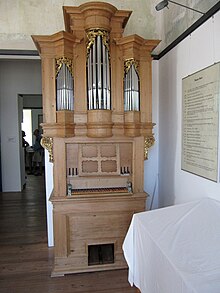Philipp Franz Schleich

Philipp Franz Schleich (* around 1686, probably in Bamberg ; † November 15, 1723 in Stadtamhof ) was a German organ builder .
life and work
Philipp Franz Schleich was probably born in Bamberg around 1686 as the son of the organ builder Adam Philipp Schleich. He was the owner of an organ building workshop in Dietfurt . Around 1715 he moved it to Stadtamhof. He died there at the age of 38. His widow married the organ builder Johann Konrad Brandenstein .
Only two of Schleich's works have survived: a chamber organ from 1718, which is in the Historical Museum in Regensburg , and an instrument built in 1720, which was in the St. Nikolauskirche on the Ilkahöhe in Tutzing until 2018 . The latter was replaced by a modern organ in 2018 and initially found a new location in the Tutzing local museum ; However, there were considerations to give it to the Organ Museum in Kelheim as a permanent loan .
Church organ in Tutzing
The unmounted organ is equipped with a short octave . About two Tretschemel air is sucked in by the players themselves two Schöpfbälge and passed into a mehrfaltigen magazine bellows for storing that the game Wind to the slider chest emits. The register circuit is operated via iron manubrons. The wooden pipes of the two Gedackt registers are 80% original, all metal pipes of the remaining registers were restored, as the original pipes were no longer usable. The keyboard and a veil board were also made from scratch.
Inside there is a parchment inscription which reads:
“Philippus Franciscus Schleich citizen and organ maker from Stadt am Hof. The organ work was finished in August in the year 1720. "
The disposition is:
|
||||||||||||||||||||
The instrument was disassembled and forgotten in the attic of the local high school. Upon a hint from the incumbent caretaker, the instrument was inspected and, according to the historical classification as an important monument organ, restored or restored by Dieter Schingnitz in 2012 .
Chamber organ in Regensburg
According to the signature, Schleich completed the five-room chamber organ on May 1, 1718. The housing is modeled on an inlaid cabinet, with panels and fittings. The elaborately carved veil board with gilded acanthus tendrils is covered with a green silk fabric . In the lower part there is the winch : Two Schöpfbälge that can operate the player with your feet even encourage air in a small magazine bellows of the game wind into the wind chest which is built as a slider chest, delivers. In the upper part sits the wind chest with the pipes and the broken keyboard . When pressed down, the buttons open the valves with a trigger. The register loops are moved by iron tie rods. The disposition is:
|
||||||||||||||||||
The instrument was restored in 1911 by Joseph Sidlo from Vienna and in 1983 by Johann Rickert. It is currently stored in the depot of the historical museum and is in playable condition. During the last restoration, an additional centrifugal fan was installed.
literature
- Eberhard Kraus : Historic organs in the Upper Palatinate. Schnell & Steiner, Regensburg 1990, ISBN 3-7954-0387-1 .
- Michael Wackerbauer: The musical instruments in the historical museum of the city of Regensburg. Universitätsverlag, Regensburg 2009, ISBN 978-3-86845-029-3 .
Web links
- Philipp Franz Schleich in the Bavarian Musicians' Lexicon Online (BMLO)
Individual evidence
- ↑ Manuela Warkocz: Finally weddings with “Ave Maria” again. In: Süddeutsche Zeitung . May 20, 2018, accessed June 17, 2019 .
- ↑ Odyssey of an Organ. In: vorort.news. May 18, 2018, accessed June 17, 2019 .
- ^ Alfred Leclaire: Reprint of the inauguration speech from 2012.
| personal data | |
|---|---|
| SURNAME | Schleich, Philipp Franz |
| ALTERNATIVE NAMES | Schleich, Franz |
| BRIEF DESCRIPTION | German organ builder |
| DATE OF BIRTH | around 1686 |
| PLACE OF BIRTH | uncertain: Bamberg |
| DATE OF DEATH | November 15, 1723 |
| Place of death | Stadtamhof |